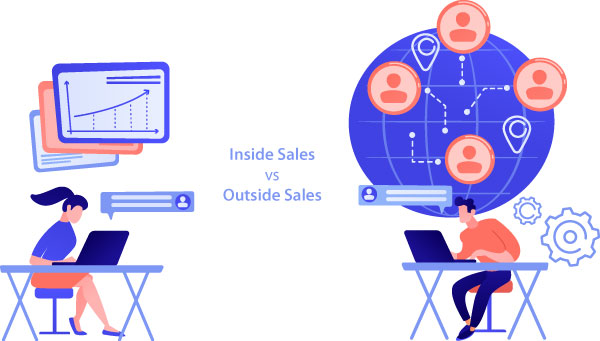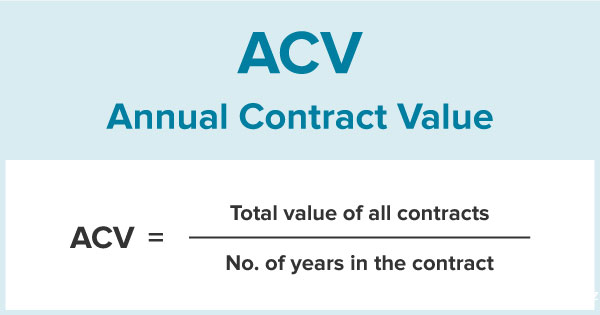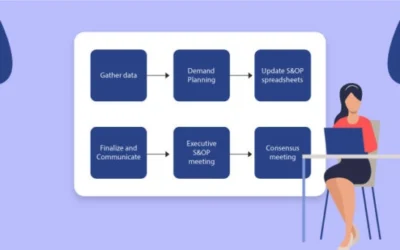Inside Sales Vs Outside Sales | Know the Difference
In those times before the advent of sales tools and technologies, sales used to be primarily done outside the office. But with the introduction of sales software and mechanisms, it shifted inside the office. And the sales process got segmented into two- inside sales and outside sales. So, organizations started determining whether to focus mainly on inside sales vs. outside sales.
But over time things again changed as companies began realizing the vital roles of each of those in their sales. And today, the two strategies have blended and the demarcation between those is almost negligible. However, there are still several key differences between them. Thus differentiating the roles of respective sales reps. This write-up discusses those in detail.
Inside Sales Vs Outside Sales- What does each term mean?

Inside sales are remote sales carried out from one’s office, from the desk of a sales rep. The rep doesn’t visit his client in person. Instead, he uses different communication tools such as email, phone, etc. This selling method is usually followed in B2B, technology, SaaS, and high-ticket B2C transactions.
Outside sales involve selling in person. The sales reps here usually deal with bigger and costlier products and services. Though a big portion of the work can be done from the office through tools like Zoom alternatives, Skype, etc., the sales rep is willing to be in person wherever and whenever needed to make the sale.
Inside Sales Vs Outside Sales- What do their Sales Reps Do?
Inside sales reps sell remotely, over the net, video call, or the phone. Stats says that they send 8.8% more emails, make 45% more calls, and make 49% more social touches than outside sales reps. They have targeted and predictable quantities of work to accomplish each day in terms of the number of proposals to be sent, dials to be made, and meetings to be booked.
On the other hand, outside sales reps sell mostly at trade shows, conferences, customer offices, and industry events by making visits and delivering speeches. However, still they spend almost half of their time in remote selling.
Even before the recent worldwide pandemic, it was reported that outside sales reps’ remote selling time had increased by 88 percent. So, it is anticipated that this percent is likely to increase even more post the pandemic.
Further, the number of inside sales reps is almost equal to the number of outside sales reps. This blurs the line between inside and outside sales. So, let’s dig into the subject of inside sales vs. outside sales further.
Discussing Inside Sales Vs. Outside Sales in Detail
Let us discuss inside sales vs. outside sales in detail under different heads such as the role of their sales reps, salaries, team structure, quota attainment, and more.
The role of sales reps

Inside sales reps are responsible for performing the following tasks.
- Demonstrating extraordinary knowledge to answer inquiries and questions from customers.
- Building relationships with prospects to initiate and reinforce trust and affinity.
- Nurturing leads to convert them to customers.
- Extracting referrals from existing customers.
- Closing customer deals.
- Achieving monthly goals.
- Reporting sales data.
Outside sales reps are responsible for carrying out the below-given tasks.
- Traveling to meet with prospects.
- Providing a personalized sales experience to prospects and current customers.
- Educating about products and their features in a detailed manner.
- Networking relationships with prospects and customers to establish trust and affinity.
- Simplifying and shortening long sales cycles.
1. Skillset required
In the case of inside sales, the sales process can be performed by less experienced sales professionals. They need to simply repeat the same set of processes at scale. Besides, they should be focused and know how to prioritize leads and deals.
For carrying out outside sales, sales reps should have high levels of emotional intelligence (aka emotional quotient or EQ). They need the ability to positively comprehend, use, and manage their emotions to alleviate stress, relate with others, communicate efficiently, subdue conflict, and conquer challenges.
Sales reps involved in outside sales should be strategically aware, and business-oriented. They should possess quick decision-making skills and know the sales techniques such as negotiation knacks.
2. Sales Cycle
The cycle of inside sales is shorter and less complicated as only a few decision-makers from the client’s end are involved. However, the annual contract value (abbreviated as ACV refers to the revenue which a current customer’s average contract value is expected to generate over a year) is lower. So, the sales team prioritizes quantity over quality.

In the case of outside sales, the cycle is longer due to the larger deal size. For instance, an aerospace firm handling government defense contracts isn’t likely to close a deal worth millions of dollars within a week. It is also complex as many stakeholders are involved. The related ACV is, however, higher.
3. The product
Products that can be sold well through inside sales are small products, products that are one-time purchases, products that are solutions to a simple and immediate issue, products with a small ACV, and products that are attractive to a mass market. Due to the lower pricing and commitment, it is convenient for people to purchase it.
In contrast, when it comes to buying more expensive and bigger products, people prefer purchasing in person. They want to see in person how it works, how it can be customized to suit your requirements, and more. This is where outside sales are efficient. So, the sale of products that are bigger and costly, products with several potential benefits, and products with a large ACV would benefit from outside sales.
4. Sales Tools

Though we have touched on this area in one of the previous sections, let’s discuss it in detail. Inside salespersons typically use PCs and phones. When it comes to digital tools, they use one-to-many automation tools including email, CRM, social media, and video conferences.
Outside sales reps travel in rental cars and use their cell phones frequently. With the evolution of mobile devices and cloud computing, certain facets of inside sales have entered into the workflows of outside sales teams. That’s why they too are connecting with prospects over calls and emails and are employing different types of CRM for tracking data.
5. Metrics that matter
To determine what works and what doesn’t both inside and outside sales teams measure their performance for several metrics. Inside sales teams evaluate the performance of their touchpoints such as emails, calls, etc. against successfully closed deals, opportunities, or connections. They emphasize achieving weekly or monthly goals.
The outside sales teams track the number of demos, presentations, or meetings that resulted in a closed sale. Unlike inside sales teams who stress weekly or monthly goals, outside sales teams weigh their achievement across quarterly and annual revenue goals.
6. Sales Team Structure

A study shows that well-established big companies, making revenue of more than 500 Million dollars, predominantly employ outside sales reps (71.2%). And small firms, making a revenue less than 50 Million dollars, have the highest percentage of inside sales reps (47%). However, nowadays, large organizations are increasing their inside sales efforts, and the trend is anticipated to continue in the days to come.
7. Sales activities
As mentioned earlier, sales organizations with a majority of insides salespersons perform significantly more work than those with primarily outsides sales reps. That is, they make more calls, send more emails, leave more voicemails, and make more social touches.
Overall, organizations predominantly having inside salespersons have a 9.8% higher quota attainment than firms with more outside salespersons. However, it is also a fact that firms with the preponderance of outside sales reps have a 30.2% higher close rate than firms with a predominance of inside sales reps.
Additionally, deals closed by outside sales teams are usually 130.2% larger on average than those closed by inside sales teams.
8. Quota Achievement
Studies say that only 60.9% of salespersons achieve their quota every year. Curiously, outside salespersons averagely have a 29.6% higher quota than their inside counterparts. Though the cent percent quota accomplishment is still far away, these results aren’t somber either.
The performance of sales in the future can be significantly improved with better communication and collaboration between inside and outside sales reps and marketing and sales teams, alongside increased productivity (owing to artificial intelligence).
Final Words…
So, Which Type- Inside Sales Vs. Outside Sales Would Suit Your Business?
Now that you have a good comprehension of both types of sales, you could have guessed whether inside sales, outside sales, or a combination of both would work for your business. For most organizations, the hybrid one would suit. However, before you decide, it would be wise to test different strategies, evaluate performance, and get a grab of what works and what doesn’t. Take advantage of technology to analyze and derive insights from your data. And then train your sales team on those tactics that are surpassingly successful for closing or losing deals. Also, go for workflow optimization. That is, evaluate your team’s workflow to detect inadequacies and ascertain those steps that can be automated for increasing productivity.



